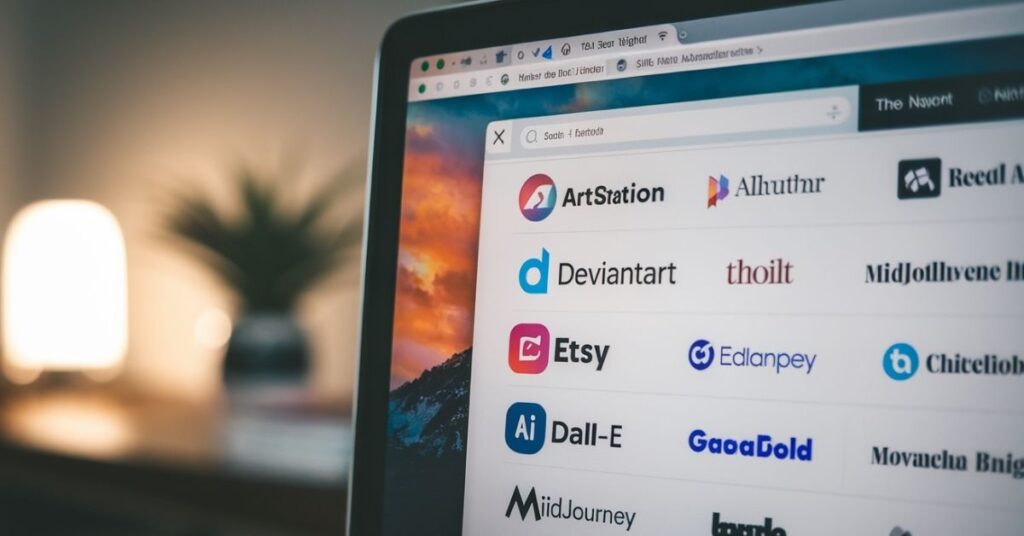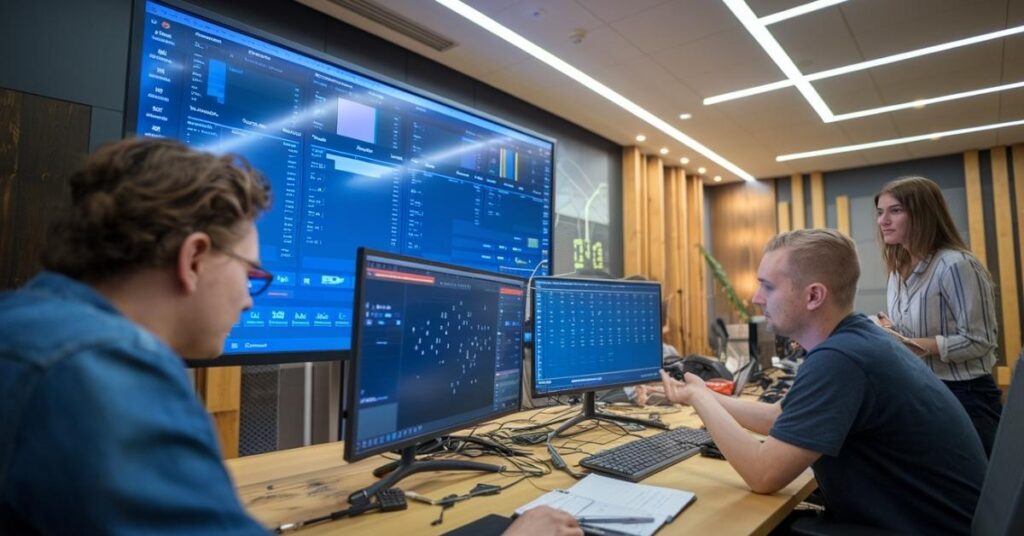Have you ever imagined turning your AI-generated art into a steady income? In 2024, the digital art world has been completely transformed by artificial intelligence. Artists are no longer limited to brushes and canvases—now, tools like MidJourney, DALL·E, and Stable Diffusion are helping creators generate stunning, one-of-a-kind art pieces. But where do you sell these creations, and how do you stand out?
This guide dives into the ten best platforms to sell AI art while providing actionable steps to kickstart your journey. Let’s explore how to transform your digital passion into profit!
How to Get Started Selling AI Art
1. Choose the Right AI Art Tool
Start by selecting an AI art generator that suits your style. Popular tools include MidJourney for painterly visuals, DALL·E for versatile designs, and Stable Diffusion for customizable outputs. Each tool offers unique strengths, so experiment to find what works for you. Focus on creating art with a specific niche, like futuristic landscapes, abstract patterns, or character designs, to attract buyers.
2. Refine and Polish Your Art
AI tools generate great results, but enhancing your artwork is essential for selling. Use editing software like Photoshop or GIMP to clean up imperfections, adjust colors, and sharpen the resolution. Adding small personal touches can also set your work apart, making it unique and professional. High-quality images attract more buyers and build trust in your brand.
3. Pick the Right Platform
Decide where you want to sell your AI art:
- For NFTs, platforms like OpenSea and Rarible are popular.
- For print-on-demand products (posters, apparel), try Redbubble or Society6.
- For direct downloads and customized offerings, go with Etsy or ArtStation.
Research each platform to understand their fees, audiences, and requirements. You can list your work on multiple platforms to maximize visibility.
4. Build a Strong Portfolio
Your portfolio acts as your digital showcase. Upload high-quality images, write clear titles and descriptions, and maintain a consistent style or theme to stand out. If possible, create a personal website or use platforms like Behance to display your best work. A professional portfolio helps attract buyers and builds your credibility.
5. Set Competitive Pricing
Pricing your art can make or break your sales. Study similar artwork to understand market trends. Offer tiered pricing: lower for simple digital downloads and higher for limited editions or NFTs. Factor in your effort, time, and the quality of your work. Start reasonably and increase prices as your demand grows.
6. Promote Your AI Art
Marketing is essential to reach buyers. Use social media platforms like Instagram, Twitter, and TikTok to showcase your work. Share creation videos, use popular hashtags, and engage with art communities online. Join AI art groups on Reddit or Discord, collaborate with influencers, and optimize your listings with relevant keywords to increase visibility.
7. Deliver Great Customer Experience
Respond quickly to buyers, ensure smooth file delivery, and maintain quality in print-on-demand orders. Adding bonuses like free wallpapers or behind-the-scenes content can set you apart. Happy customers often return for more and recommend your work to others.
10 Best Platforms to Sell AI Art in 2024
1. OpenSea
As one of the largest NFT marketplaces, OpenSea remains a top choice for AI art creators. With a focus on digital assets, OpenSea allows you to list and sell AI-generated artwork as NFTs (non-fungible tokens). The platform attracts collectors seeking unique, tokenized art pieces.
How to Start on OpenSea:
- Connect your crypto wallet (like MetaMask).
- Mint your AI artwork into NFTs.
- Set pricing—either fixed or auction-based.
OpenSea’s user-friendly interface makes it ideal for beginners venturing into the NFT world.
2. Etsy
Etsy, traditionally known for handmade crafts, has evolved to accommodate digital art—including AI creations. Many buyers on Etsy are looking for art prints, posters, and digital downloads, making it a profitable space for AI artists.
To succeed on Etsy, focus on creating versatile pieces that people can use in homes, offices, or digital projects. For example, minimalist AI designs or vibrant abstract art often perform well.
Etsy also allows you to offer downloadable art files, reducing delivery hassles. A strong, searchable product description will help buyers find your work.
3. Redbubble
Redbubble is a print-on-demand platform where artists upload their designs, and Redbubble handles the printing, shipping, and customer service. AI artists can turn their digital creations into products like t-shirts, posters, stickers, and mugs.
To get started, create a Redbubble account and upload your high-resolution AI art. The platform’s global reach ensures that your work is accessible to buyers worldwide, and you earn a commission on every sale.
Redbubble’s appeal lies in its ability to turn art into practical products, which can broaden your potential customer base.
4. DeviantArt
DeviantArt has been a long-time hub for digital artists and remains relevant for AI creators in 2024. With its supportive community, DeviantArt is not just a platform to showcase art but also a marketplace where you can sell your work.
You can list AI-generated art as digital downloads or prints. Engaging with the DeviantArt community by sharing progress shots or tutorials also helps build a loyal following, leading to more sales.
5. SuperRare
SuperRare is an exclusive marketplace focused on high-quality NFT art. If you’re confident in the uniqueness and craftsmanship of your AI creations, SuperRare is a platform to consider. It targets serious collectors willing to pay a premium for extraordinary digital art.
However, SuperRare is more selective—you’ll need to submit an application to join. If accepted, your art will be part of a curated collection, increasing its perceived value.
6. ArtStation
ArtStation is a platform popular among professional artists, illustrators, and designers. AI art is finding its place here as digital artists experiment with AI tools. On ArtStation, you can sell prints, digital downloads, and even tutorials for fellow creators.
ArtStation also offers a portfolio-building option that helps showcase your AI work to potential buyers and clients. If you’re looking for credibility and visibility within the art world, ArtStation is a strong choice.
7. Foundation
Foundation is another premium NFT marketplace designed for digital artists, including AI creators. Known for its sleek, curated experience, Foundation attracts serious collectors seeking unique NFT pieces.
Selling here requires an invitation from a fellow artist, making it more exclusive. However, if you gain access, Foundation’s audience is highly engaged and willing to invest in quality AI art.
8. Saatchi Art
Saatchi Art is an online gallery that allows artists to sell original artwork, including digital art. AI artists can upload their creations and market them as limited-edition prints.
The platform attracts serious art buyers and collectors, making it ideal for creators looking to position their AI work as high-value art pieces. By presenting your art as exclusive, you can establish yourself as a professional digital artist.
9. Fine Art America
Fine Art America is a print-on-demand platform tailored for artists who want to sell art prints and merchandise. AI creators can upload their work, and Fine Art America will produce and ship products like canvas prints, phone cases, and tote bags.
The platform’s built-in tools also allow you to set pricing, track sales, and manage orders seamlessly. With a large customer base, Fine Art America helps you reach buyers interested in both artistic and functional designs.
10. Rarible
Rarible is another leading NFT marketplace that supports AI-generated art. Like OpenSea, it allows you to mint, list, and sell digital assets. Rarible also offers customization options, giving creators flexibility with how they present their work.
The platform supports multiple blockchain options, making it accessible to a broad range of crypto enthusiasts.
What Makes AI Art Sellable in 2024?
The rise of AI art isn’t just a trend—it’s a new frontier for creative expression. What sets AI-generated art apart is its ability to merge human imagination with machine precision. This combination leads to pieces that are bold, futuristic, and unlike traditional art.
To successfully sell AI art, you must focus on two key elements: creativity and market relevance. Buyers, whether art enthusiasts or commercial clients, look for unique visuals that align with current trends. High-resolution images, captivating themes, and storytelling through art are essential to stand out.
Many AI artists are now leaning into styles like futuristic cityscapes, surreal dreamscapes, and intricate patterns. While creativity is limitless, understanding what resonates with your audience can make all the difference.
Final Thoughts
Selling AI art in 2024 offers limitless opportunities for creative individuals. By choosing the right platforms and marketing your work effectively, you can turn AI-generated art into a profitable venture. With tools, communities, and marketplaces at your fingertips, now is the perfect time to share your creations with the world.
So, start creating, start selling, and let your AI art shine!


